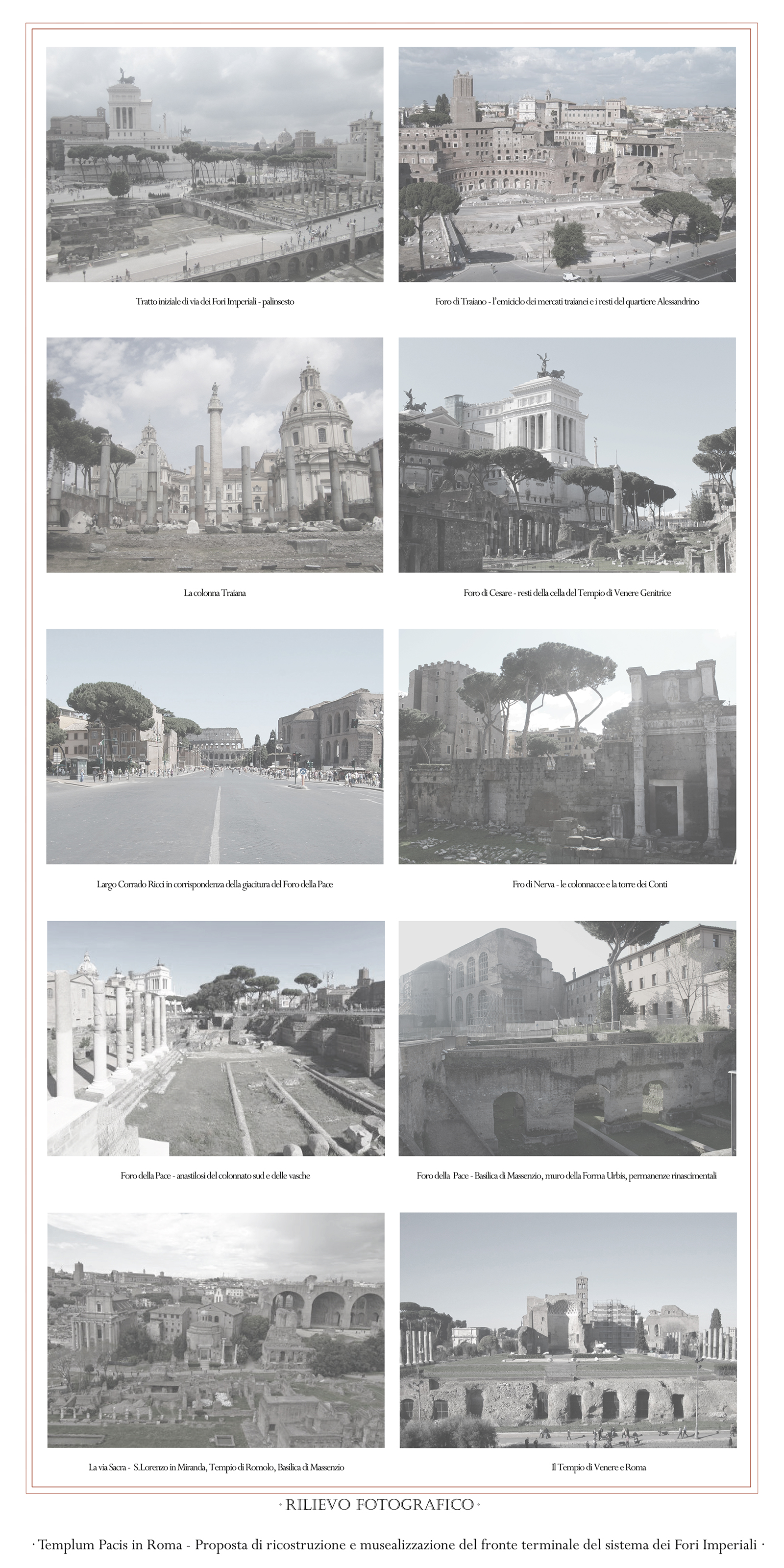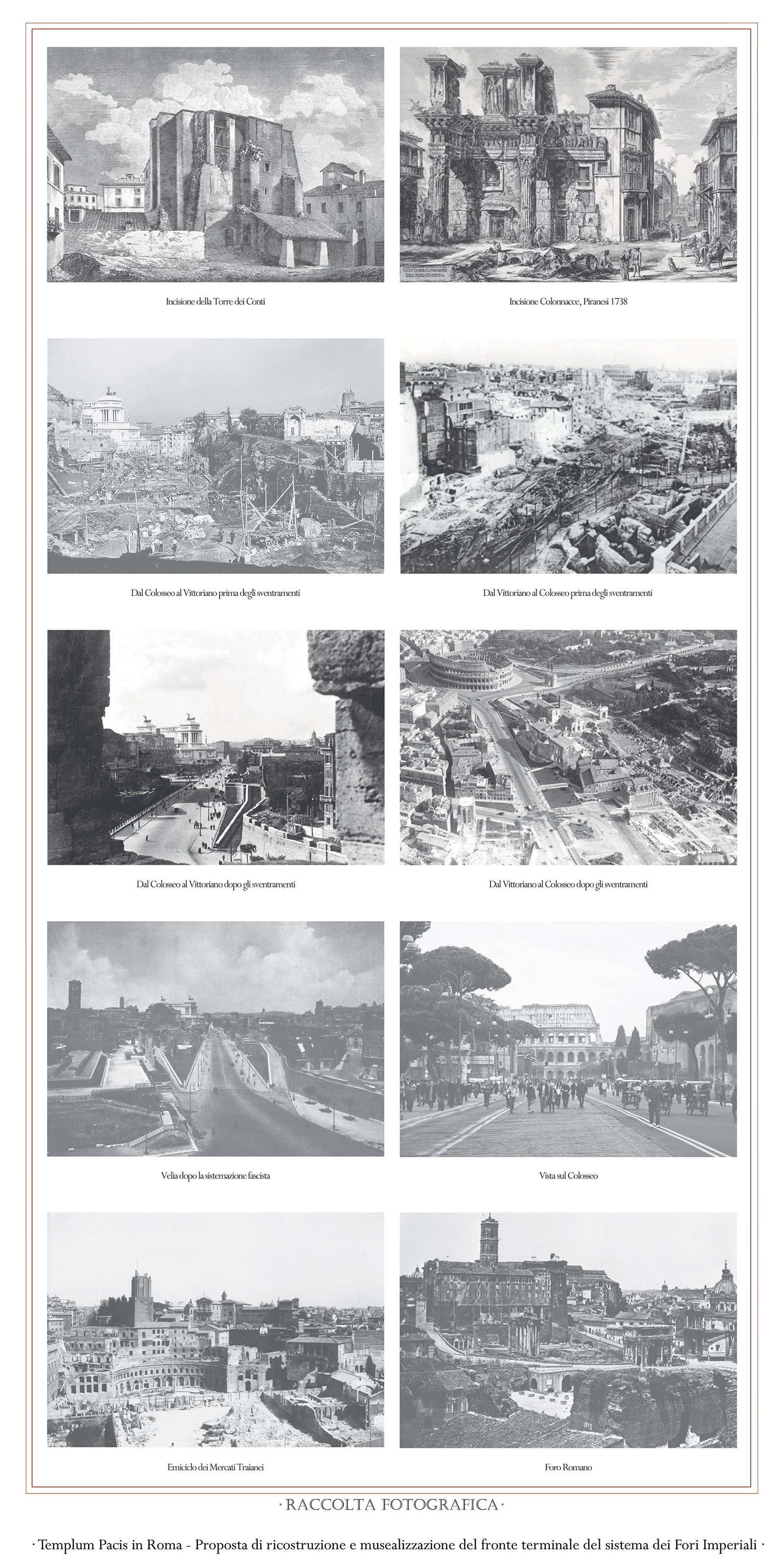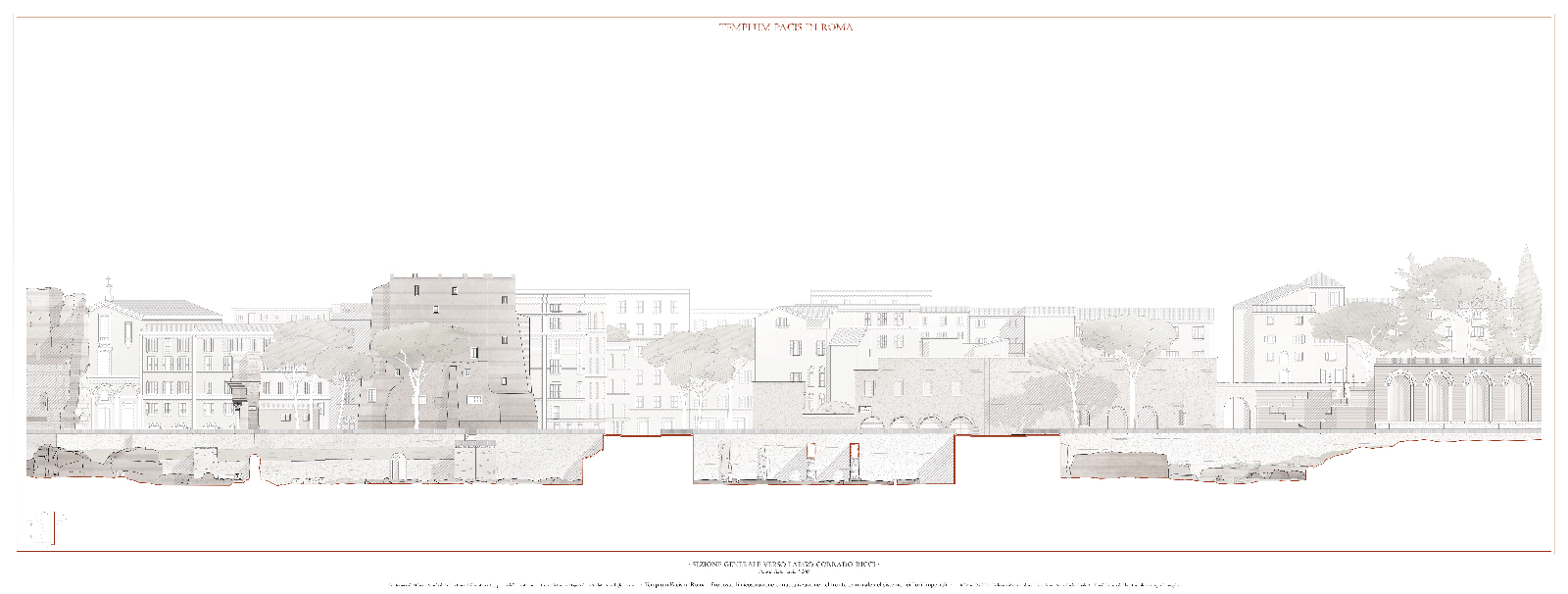Tesi di Laurea

TEMPLUM PACIS IN ROMA.
Proposta di ricostruzione e musealizzazione del fronte terminale del sistema dei Fori Imperiali.
Candidati
Alice Baccolo, Giorgia Fumagalli
Relatore
Pier Federico Caliari
Correlatore
Paolo Conforti
Anno Accademiaco
2016/2017
L’Area Archeologica Centrale può essere definita come un palinsesto ricco di segni e giaciture, un’immagine complessa. Gli scavi moderni, in questo ambito, stanno portando in luce la trama antica, la cui interpretazione risulta ancora di difficile lettura, non risolta. Non sono chiari i limiti, le sequenze temporali e soprattutto spaziali tra i nuclei. Ai fini della comprensione e della musealizzazione di quest’area è inevitabile dunque affrontare il tema della restituzione di senso e forma allo scavo. Nell’ambito dell’Area Archeologica Centrale il tratto più articolato e meno conosciuto è certamente quello in prossimità di Largo Corrado Ricci e della Basilica di Massenzio, dove i parziali scavi confermano oggi la corrispondenza – indagata e ipotizzata da Gian Battista Nolli nell’700 e da archeologi contemporanei come Andrea Carandini – col complesso di età imperiale storicamente noto come Templum Pacis. Il Foro della Pace, costruito nel 75 d.C. sotto l’imperatore Vespasiano, è stato fondamentale per la costituzione dell’asse che ancora oggi definisce l’intero sistema dei Fori Imperiali; esso inoltre ha ricoperto il ruolo di cerniera che, nell’antichità, collegava la Suburra al Foro romano. Il tempo ha cancellato i segni della sua presenza e ne ha ridotto l’evidenza fisica a pochi ruderi, rinvenuti solo grazie a recenti campagne di scavo. La priorità è stata dunque, affrontando il progetto di quest’area, restituire una lettura unitaria, oggi infranta, ad un complesso così particolarmente frammentato. Si sono dapprima ridefiniti i limiti andando a ridisegnare il tracciato stesso di Via dei Fori, ristabilendo gli ambiti dei singoli complessi forensi e i loro perimetri, al fine di fornire una chiara lettura dell’intero paesaggio archeologico. Questo in linea con i tracciati storici che hanno caratterizzato ciascuna epoca, essendo ognuno di essi fondamentale per la costituzione dell’intero palinsesto dell’Area Archeologica Centrale. Nello specifico il progetto ha affrontato l’area del Foro della Pace, riconoscendone il ruolo strategico nel complesso del sistema dei Fori, ricostruendo ed evocando i margini e le volumetrie del Foro di Vespasiano riportando alla luce una maggiore superficie. L’intervento si configura quindi come una musealizzazione in situ del Foro della Pace, all’interno del quale sono stati raccolti i frammenti della Forma Urbis Romae, pianta marmorea della città risalente al periodo severiano. Volumetricamente poco invasivo, in un’area già densa e ricca di elementi, il progetto prende forma prevalentemente nell’interstizio tra la quota archeologica e l’attuale via dei Fori riconnettendo, attraverso una passeggiata archeologica continua e comune a tutti i fori, due livelli oggi fisicamente, idealmente e percettivamente distinti tra loro. Con questo progetto si è voluto inoltre rafforzare il suo ruolo di cerniera ristabilendo la connessione con l’oggi inaccessibile Tempio di Romolo, volume di collegamento con la Sacra Via, e riaprendo il tracciato della Via ad Carinas, limite del Templum Pacis e asse di connessione col Foro romano. Questo ultimo intervento è possibile ipotizzando la musealizzazione del livello sostruttivo della Basilica di Massenzio, ripristinando l’accesso all’edificio attraverso il passaggio storico dell’arco del Latrones. La ricostruzione e la musealizzazione del fronte terminale del complesso dell’Area Archeologica Centrale vogliono quindi essere la proposta per risignificare questo luogo, rimuovendone l’ambiguità e l’anonimato, per rievocarne la magnificenza che già Plinio il Vecchio e Svetonio esaltavano nei loro scritti.
The “Central Archaeological Area” can be described as a rich plot of architectural signs, levels and backgrounds merged in a complex and articulate portrait. In this peculiar context, the modern excavations have revealed the ancient web, whose interpretation is still an interesting subject matter for the insiders because it is still simply unsolved. The limits, the spatial and temporal sequences between the site’s functional units are still unclear. In order to understand and to proceed through the musealization of this area, it is necessary to investigate and to discover the archaeological site original shape and function. Regarding the “Central Archaeological Area”, the most chaotic and unknown part is definitely the one which is around “Largo Corrado Ricci” and Massenzio’s Basilica, where spot excavations have revealed its correlation – already investigated by Gian Battista Nolli during the XVII century and by many other ontemporary Archaeologists like Andrea Carandini – to the imperial age architectural complex known as “Templum Pacis”. “Foro della Pace”, erected in the 75 a.c. under the Emperor Vespasian reign, has been a fundamental reference for the following urban development of the entire system of the “Fori imperiali”, being regarded as the “hinge” or the “connection” between the old “Suburra” and the heart of the town itself: the Foro. The time has deleted any trace of its presence, reducing all its majesty to a few wrecked ruins reemerged only after recent excavations. Since the early stages, to approach this project based on such a fragmented complex, our priority was to return to this site its unity and its original appearance that has gone lost during the ages. Technically, the first step we have been through was about redefine the boundaries and the original path of “Via dei Fori”. We have restored the edges and the extension of the various ancient squares, Fori, aiming to give the right reading to the entire archaeological site, without distortions and alterations to the footprints impressed during the various ages, whose contribution have been fundamental to the characterization of the “Central Archaeological Area” itself. Our project is mainly focused on the “Foro della Pace” area, stressing and relying on its key role in the articulated system represented by the “Fori Imperiali” site, aiming to restore its original shape and enhance the ancient dimensions of the “Foro di Vespasiano” by unearthing a larger part of it, the one that has been buried and hided underneath the surface during the centuries. The project has soon become an on-site musealization of the “Foro della Pace” in which have been collected and reorganized a large number of fragments belonging to the ancient marble composition called “Forma Urbis”. Dimensionally modest, located in an already congested area, our project has been deployed on a middle level, between the archaeological layer and the pedestrian ground of “Via dei Fori Imperiali” with the aim to link, through a shared “historical walkway”, ancient squares and buildings that lies on different levels, that have been detached both physically and ideally for ages. Through this project, we aimed to strengthen the role of the so called “Tempio della Pace”, that acts as a hinge for all the surrounding architectures, restoring the connection to the inaccessible “Romolo’s Temple”, bonding element with the “Holy Way”, and by reopening the old path of “Via ad Carinas”, connection axis to the “Foro Romano”. This very last part of our project, have been possible by the musealization of the level where all the supporting structures of Massenzio’s basilica are located and by the restoration of an old entrance through an historical opening. The restoration and the musealization project of the “Central Archaeological Area” can be described as the proposal to give a new life and a new meaning to this unique historical and architectural complex, removing its ambiguity and restoring its ancient beauty already witnessed in the writings of Plinio il Vecchio and Svetonio.





















